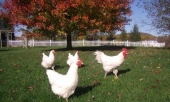In the spirit of permaculture, I want to divide my small 4 acres and have some permanent boundaries planting areas that have been turned to pasture to be edged with a hedgerow and to that end I have started planting spruce, cedar, maple, giant sequoia , aspen, weeping willow, fir, stone pine , hawthorne, as well as pear, apple, cherry, plums, hazelnut, walnut and chinese chestnut on the perimeter of my property. My goals are to have some food, wildlife habitat, keep my beasties in , privacy, keep others beasties out, and have some future wood harvest.
I have utilized mature conifers as fencing with electrical hot rope for fencing in my horses , currently powered on a grid charger and an additional solar charger.

In conjunction with other fencing a secure gravel paddock for in the back is adjustable to 7 feet but the height of hot wire is quickly adjustable for different types of livestock, I happen to have horses bred for jumping. I am strategically planting treees to serve as fencing such as this in the future.

My experiment with interior fencing was to see if I could make an adjustable configuration of hot rope fencing so I could better manage paddock grazing, for instance focus wet weather turnout of animals onto higher dryer ground. Or adjust an individual area to rotate a different kind of animal in such as geese in the orchard or poultry, by in time purchasing electrical poultry net fencing.
Other areas I wanted to preserve in my planning was to establish a lane between two pastures to seperate my stallions from each other or mares in the adjacent pasture, but I also wanted to plan for a jumping exercise area , we call it a jumping chute where young horses school through a lane of free jumps without a rider. So my areas need to have high levels of utility because of the limited area of a 4 acre farm.
So I am experimenting with interior hand dug 10 foot posts set in a grid of aproximately 60 feet by 60 feet with removable hot wrire rope being able to be adjusted to configure paddocks into differing sizes and configurations .


Basically this is my experiment so at present I have left the ropes cut extra long for making them adjustable where need be with any slight differences in the post distances

As you can see, we can now concentrate grazing in one area before rotating to the next , or rotate differing animals in succession to better manage the land using the Salatin idea of chicken tractors following cattle, or in our case, horses.
The temporary white posts supply vertical support to keep the elecrical fencing from sagging , spaced closer and used in conjunction with electrical poultry netting I think I could be flexible to contain and rotate chickens, turkey, sheep, goats, geese, pigs, cows etc.










































































